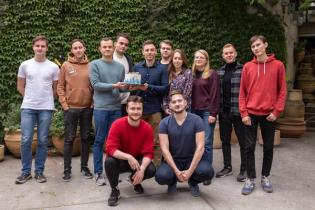From our experience, every third project fails because of the expectation mismatch. But why does that happen? Well, there’s no single answer — the root cause can be for instance the lack of communication, incomplete requirements, different process understanding, etc. Given that all of our clients are trying to improve and expand their business, there isn't always extra time to study tons of new information.
We at Stormotion always try to put ourselves in the client's shoes and to adhere to the main truth of any business — time is money. That’s why we prepared a short guide on how the project development process works from our customers' perspective so that you have a better understanding of the journey that awaits us!
📄 Pre-Discovery stage
So, let’s imagine that you’ve chosen Stormotion and shared with us your main business & development challenge to solve. Once we get that very first input, we put it into a development context in order to identify and formulate the main tasks. Once we have them, we analyse them in order to create an estimable work breakdown, so that you can better understand the structure of required effort, prioritise features, and manage version limitations.

At this stage we gather all the info we have to get a better understanding of the project (image by QClay)
Our very first step is to identify the basic concept, goals, and requirements of the project, and backlog to present a complete picture of our further operations. To form a project vision
During this stage, we also do a rough estimation of the full project to help the client understand the structure of the required effort, prioritize features, and manage version limitations. For example, we might estimate that it will take approximately 200 hours to develop the app's core functionality and another 100 hours to implement additional features requested by the client.
🔎 Discovery stage
At the discovery stage, we conduct detailed research to determine how to achieve the project goals. This includes identifying any technical limitations or challenges, such as the need to integrate with external services or devices.

During the discovery stage, we look for the best way possible to build a product that will perfectly meet your business goals (image by Karolina Kalinowska)
Besides the technical side of the research, we also work with the creative & business side of the project, namely the initial structure of the application — User Experience. Simply put, this is how the user interacts with the interface and how convenient the site or application is for them. For example, we might create wireframes to show the client how the app will look and function.
The main output of this stage is a more comprehensive project budget, scope, schedule, resources, project communications, and risk management based on the information we receive. These components can change during the project, but planning everything in advance will help us to be more flexible with further development.
⚙️ Development (Project Execution, Project Monitoring, and Controlling) (#development}
The purpose of project execution is to complete the work specified in the project roadmap and achieve the project goals. During this phase, we focus on including stakeholders, working with the team to fulfill tasks, adhering to processes, and communicating as planned. For example, we might hold regular meetings with the client to discuss progress and address any questions or concerns.
Throughout the entire development phase, we adhere to the principle of Continuous Delivery (Agile methodology) — when after every agreed period of time we provide and demonstrate to our customers the part of the work that has been completed. Usually, it happens once in two weeks.

The development stage is when all the magic is happening (image by HoangPts)
This way, you can always check and even test the functionality. Another advantage of this approach is saving development time by not having to create visual prototypes (which have no technical functionality), for example in Figma.
We also establish regular communication events to keep everyone on the same page and effectively manage feedback. For example, we might hold a weekly video call to discuss progress and address any issues. By understanding the state of progress, we can take corrective action, fast track, and reassess the schedule as needed.
🗃️ Project closure
During project closure, we transfer the completed project to those who will use it and collect customer feedback on the product and project. This step confirms that all project requirements have been met.

This is the wrap-up stage when we confirm that all the requirements have been met and plan our next, post-release steps (image by Graphic Mall)
For apps, this usually includes the release of the product in the Apple and Google stores. For example, we can submit the app for review and once it is approved, it will be available for download in the app stores.
If you'd like to dive deeper into our project management flow, we have an extended guide on this matter:
💡 Takeaways
Making our customers happy is one of our company’s key priorities.
Therefore, we use only the best and most modern technologies and practices of project management for its successful implementation.
And even after your app is deployed, we'll be there to provide ongoing maintenance in the maintenance stage, fixing bugs, adding new features, and updating as needed. For example, we might release updates to the app to fix bugs or add new features requested by users.
We hope this overview of our development process gives you a sense of how we approach software projects. Thank you for considering us for your project needs!

![Stormotion client Pietro Saccomani, Founder from [object Object]](/static/40e913b6c17071a400d1a1c693a17319/b0e74/pietro.png)


